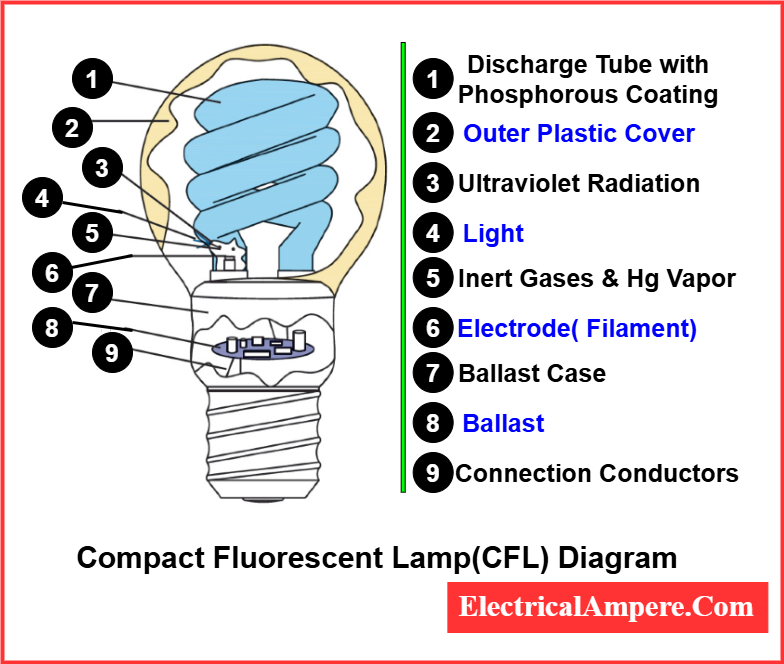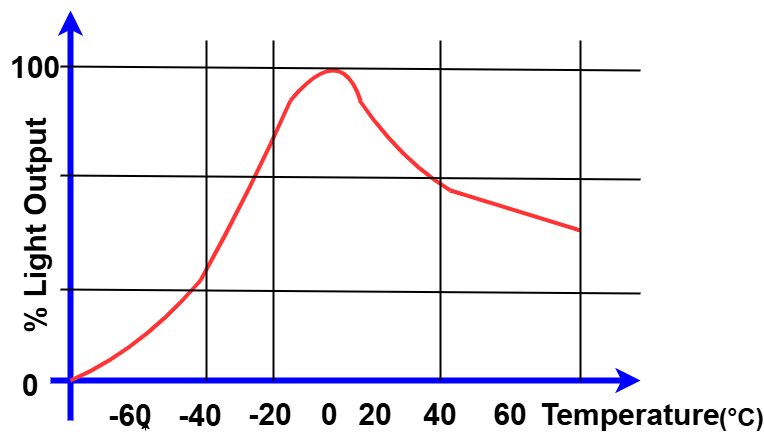CFL full form is Compact Fluorescent Lamp. CFL lamps, or Compact Fluorescent Lamps, are energy-saving light sources that have revolutionized residential and commercial lighting. Compared to traditional incandescent bulbs, they offer better efficiency, longer life, and reduced heat emission.
In this article, you’ll learn what is CFL, how compact fluorescent lights work, their structure, uses, and how they compare with LED bulbs. We’ll also cover CFL full form, types like CFL bulb 4-pin, and include a clear CFL lamp diagram.
Brief History of CFL Lamps
The Compact Fluorescent Lamp (CFL) emerged as a response to the global energy crisis of the 1970s. During this time, lighting manufacturers sought energy-efficient alternatives to traditional incandescent bulbs. In 1976, Edward E. Hammer, an engineer at General Electric, developed the first spiral-shaped CFL. Although GE did not initially commercialize the design due to complex production requirements, the concept laid the foundation for future innovations.
CFL lamps began entering the consumer market in the 1980s and gained widespread adoption in the 1990s and early 2000s. Their popularity grew due to significant energy savings, longer lifespan, and reduced heat output compared to incandescent bulbs. CFLs became a go-to solution for homes, offices, and industrial spaces until light-emitting diodes (LEDs) eventually began to dominate the energy-efficient lighting market.
Today, while CFL usage is declining in favor of LEDs, they remain an important milestone in the evolution of modern lighting.
CFL Bulbs Full Form
The full form of CFL is Compact Fluorescent Lamp. This term refers to a type of energy-efficient lighting that uses a compact version of a fluorescent tube.
CFL bulbs are designed to fit standard light sockets and provide more efficient lighting than traditional incandescent bulbs. They are also referred to as compact fluorescent light bulbs or compact fluorescent tubes, depending on the shape and design.
What Is Compact Fluorescent Lamp (CFL)?
A compact fluorescent light is a type of fluorescent lamp designed in a compact form factor to replace incandescent bulbs. It uses less power and lasts significantly longer.
CFLs work by driving an electric current through a tube containing argon gas and a small amount of mercury vapor. This produces ultraviolet (UV) light, which excites a fluorescent coating (phosphor) inside the tube to emit visible light.
Construction of CFL Lamp
A Compact Fluorescent Lamp (CFL) is designed with several essential components that work together to produce light efficiently. Here’s a breakdown of its internal structure:
- Glass Tube (Spiral or U-Shaped):
The main body is a compact or spiral-shaped tube filled with a low-pressure mixture of argon gas, mercury vapor, and liquid mercury. This mixture plays a key role in UV light generation. - Phosphor Coating:
The inner surface of the tube is coated with three-band phosphors. These phosphors convert invisible ultraviolet (UV) radiation into visible white light when excited. - Electrodes:
Located at both ends of the tube, these are responsible for initiating an electric arc when a voltage is applied. This arc excites the mercury atoms and starts the lighting process. - Ballast (Electronic or Magnetic):
A crucial part of the CFL circuit, the ballast provides a high initial voltage to strike the arc and then limits the current to safe operating levels. Without this, the lamp could overheat or get damaged. Modern CFLs typically use electronic ballasts for better efficiency and flicker reduction. - Base and Cap:
The CFL is enclosed in a base that houses the ballast and connects to fixtures. It comes in various forms like screw bases (E27, E14) or CFL bulb 4-pin bases, allowing easy installation into different lighting sockets.
CFL Lamp Diagram
The following diagram illustrates the key components of a CFL lamp, including the gas-filled glass tube, phosphor coating, electrodes at each end, and the electronic ballast integrated in the base. This visual helps understand how these elements work together to produce light efficiently.

Working Principle of CFL Lamp
The CFL lamp working principle is based on gas discharge and phosphor fluorescence:
- Electricity flows through the electrodes at both ends of the gas-filled tube.
- The electric current excites mercury vapor, generating ultraviolet radiation.
- The UV light strikes the phosphor coating inside the tube.
- The phosphor emits visible white light.
This process is more efficient than incandescent bulbs, which produce light by heating a filament.
Types of CFL Lamps
Compact Fluorescent Lamps come in several types based on their shape, base design, and intended use. Understanding these helps in selecting the right CFL for different applications:
1. Spiral CFLs
- Most common in household use.
- Designed to replace standard incandescent bulbs.
- Compact size fits most fixtures.
- Offers high efficiency with a familiar screw-in base.
2. U-Bent CFLs
- Shaped like a “U” or twin tubes.
- Suitable for compact fixtures, table lamps, and ceiling lights.
- Offers better light distribution than single-tube designs.
3. Circular CFLs
- Round design ideal for decorative or aesthetic lighting.
- Common in vanity mirrors, designer ceiling lights, and wall fixtures.
- Evenly distributes light in all directions.
4. CFL Bulb 4-Pin
- Typically used with external or electronic ballasts.
- Found in industrial luminaires, recessed ceiling fittings, and commercial applications.
- Not compatible with standard household sockets.
- Preferred for long-life and high-efficiency lighting in large-scale setups.
5. Plug-In CFLs
- Available in 2-pin and 4-pin variants.
- Used in fixtures with a built-in ballast.
- Common in offices, retail spaces, and hospitals.
Applications of CFL Lamps
Application of CFL lamp spans across:
- Residential lighting (homes, lamps, desk lights)
- Offices and commercial buildings
- Street lighting (in compact luminaires)
- Retail spaces and showrooms
- Schools and hospitals
They are ideal where consistent, bright light is needed and energy savings are a priority.
CFL Bulbs vs LED: Which Is Better?
| Feature | CFL Bulb | LED Bulb |
|---|---|---|
| Energy Efficiency | Moderate (60–70 lm/W) | High (90–120+ lm/W) |
| Warm-Up Time | Few seconds | Instant-on |
| Lifespan | 8,000–10,000 hours | 25,000+ hours |
| Contains Mercury | Yes | No |
| Cost | Lower initial cost | Higher initial cost |
| Dimming Support | Limited (depends) | Excellent (modern models) |
While CFL bulbs are efficient and economical, LEDs outperform them in almost every aspect, especially in energy consumption and lifespan.
Effect of Temperature on CFL Performance
Ambient temperature plays a critical role in determining the performance and light output of a Compact Fluorescent Lamp (CFL). The graph below illustrates how CFL brightness varies with changes in surrounding temperature.

At low ambient temperatures, the light output can drop to nearly one-third of its rated value.
This occurs because mercury vapor condenses at lower temperatures, especially below the optimal lamp wall temperature of 38 °C, which reduces UV radiation generation — and thus visible light.
In contrast, at or near optimal temperature, CFLs perform efficiently, delivering their rated brightness and efficacy.
Advantages of CFL Lamps
- Consume up to 75% less energy than incandescent bulbs, resulting in major energy savings.
- High luminous efficiency of around 50–75 lumens per watt, making them a cost-effective lighting option.
- Produce less heat, improving safety and reducing the load on air conditioning systems.
- Start instantly and typically do not require external starting gear.
- Longer lifespan than incandescent lamps, reducing the frequency of replacements.
- Good color rendering, making them suitable for indoor and task lighting.
- Available in various color temperatures, allowing users to choose between warm or cool lighting for different spaces.
Environmental Benefits of Using CFLs
- Lower CO₂ emissions: CFLs consume less electricity, leading to reduced greenhouse gas emissions from power plants.
- Supports environmental sustainability by decreasing the overall carbon footprint and reducing the energy demand placed on natural resources.
Disadvantages of CFL Lamps
- Contain small amounts of mercury, which requires careful handling and eco-friendly disposal
- Not environmentally friendly due to mercury content
- Higher initial cost compared to incandescent bulbs
- Delayed start or warm-up time before reaching full brightness
- Sensitive to temperature and humidity, affecting performance in certain environments
- Not suitable for frequent on-off cycling, which can reduce lifespan
- Incompatible with some timer switches or dimmers, leading to shortened life
- Can fail prematurely if overheated, especially in enclosed fixtures
- May cause flicker, leading to stroboscopic motion—a visual illusion where moving objects appear stationary or distorted under flashing light
How to Clean Up Broken CFL Bulbs
A broken CFL bulb can release a small amount of mercury vapor, so it’s important to follow safety precautions during cleanup. According to the U.S. Environmental Protection Agency (EPA), here’s how to handle it safely:
- Ventilate the area: Open windows and turn off any central heating or cooling to prevent fumes from circulating. Wait at least 15 minutes before cleaning.
- Wear gloves: Avoid skin contact with broken glass and mercury residue.
- Pick up large pieces: Use stiff cardboard to scoop up glass shards.
- Remove small fragments: Use sticky tape to lift tiny debris from floors or surfaces.
- Wipe the area: Gently clean the spot with a damp paper towel.
- Dispose properly: Place all materials (glass, tape, paper towel) in a sealed plastic bag and discard it according to local hazardous waste guidelines.
Tip: Always wash your hands thoroughly after cleanup.
How to Recycle CFL Lamps/Bulbs Properly
Compact fluorescent lamps (CFLs) contain small amounts of mercury, so they should never be thrown in regular household trash. Recycling them properly helps prevent environmental contamination and supports safe material recovery. Always treat used CFLs as hazardous household waste.
Proper CFL Recycling Tips:
- Store safely: Keep burned-out CFLs in a secure container to avoid breakage.
- Avoid breaking: Never crush or bend CFL bulbs before disposal.
Where to Recycle CFL Lamps
Many retailers and waste centers offer free CFL recycling services:
- Local facilities: Municipal hazardous waste centers often accept CFLs.
- Online tools: Use Earth911.com or your local government’s waste management site to find recycling locations near you.
Conclusion
CFL lamps have played a significant role in energy-saving lighting solutions. While newer LED technologies are now dominant, compact fluorescent lights still serve many niche applications due to their cost-effectiveness and availability.
Whether you’re exploring what is compact fluorescent, how CFL lamps work, or choosing between CFL bulb vs LED, understanding their structure and functionality helps you make informed decisions.
FAQs on Compact Fluorescent Lamps
CFL stands for Compact Fluorescent Lamp. It’s an energy-efficient lighting device that uses fluorescence to generate visible light.
A compact fluorescent tube is simply a compact form of traditional fluorescent tubes, often bent or coiled for use in small fixtures. Both use the same working principle.
A CFL bulb 4-pin is designed to be used with external ballasts. It is common in commercial lighting fixtures and offers more flexibility in replacing ballasts.
In most cases, LED is superior due to longer life, better efficiency, and no mercury. However, CFLs may still be used where budget constraints or fixture compatibility exist.
Yes, CFLs should be properly recycled due to their mercury content. Most municipalities have recycling programs for safe disposal.
When a CFL breaks, a small amount of mercury vapor is released. However, the mercury disperses quickly, especially if the room is ventilated. Studies show that by the time you gather cleaning materials and begin the cleanup, the vapor has usually diluted to a level that no longer poses a health risk—provided the area is properly aired out.
The health risks from using CFLs are very low because they contain only a small amount of mercury—typically less than 5 mg, which is roughly equivalent to the amount of ink on the tip of a ballpoint pen. The mercury is mostly sealed inside the bulb, and only trace amounts are present as vapor. For healthy individuals of any age, the risk of exposure is minimal during normal use.
For additional technical insights and historical development, you can read more on Compact Fluorescent Lamp – Wikipedia.
Related Articles: